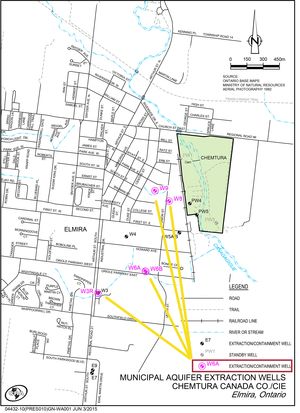Asia
EMEA

Offsite Groundwater Remediation
This effort addresses legacy contaminants in groundwater that had historically moved away from under the Elmira site towards the south and west. A number of offsite extraction wells pump contaminated water from the aquifer to a system that treats this water. A network of approximately 300 groundwater monitoring wells track the overall progress of the offsite remediation. In the late 1990s, the government set a 30-year target date of 2028 to clean up the drinking water aquifer, and the company developed and implemented a remedial action plan in order to meet the target.
Here you find a map of the extraction well locations and (below)plots that show (NDMA) concentration contours in the Upper Municipal Aquifer (MU) in 1998 (before offsite groundwater remediation commenced), in 2015, and the modeled concentrations for 2028. Each contour line indicates a 10-fold improvement difference in concentrations; a darker color indicates higher concentration. The peak NDMA concentration off site has been reduced 100-fold since 1998 and the NDMA plume mass has been reduced by approximately 95% in the MU since remediation began. Model predictions showed 99% removal and approximately 0.75 kg of NDMA remaining in the aquifer by 2028; However, even this magnitude of reduction and low remaining NDMA will still not be enough to meet the 2028 deadline under some interpretations.
While we know that the 2028 target, as it was defined and understood in the 1990s will not be met, LANXESS remains committed to working with the Ministry of the Environment, Conservation, and Parks (MECP), Region of Waterloo, and community stakeholders to adapting our remediation methods based on newer remediation practices. Though at the early stages, we have begun discussions with stakeholders about the sustainability of pumping the precious aquifer water, and how that fits with ultimate remedial and global sustainability goals.


